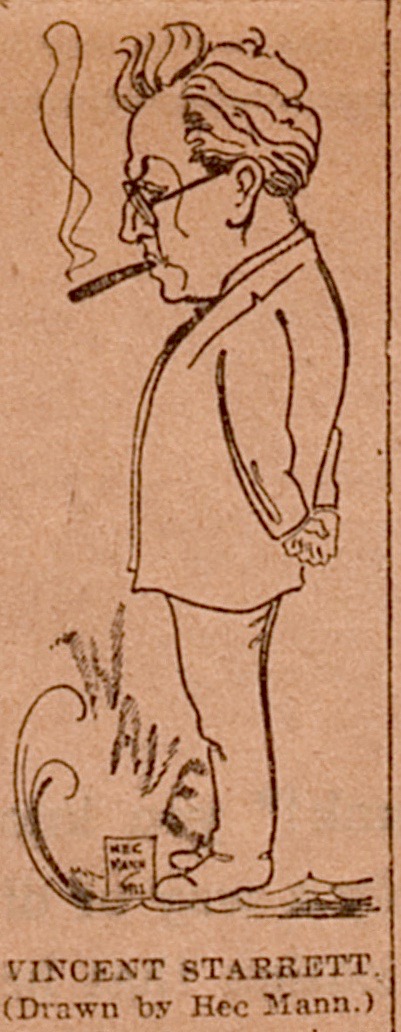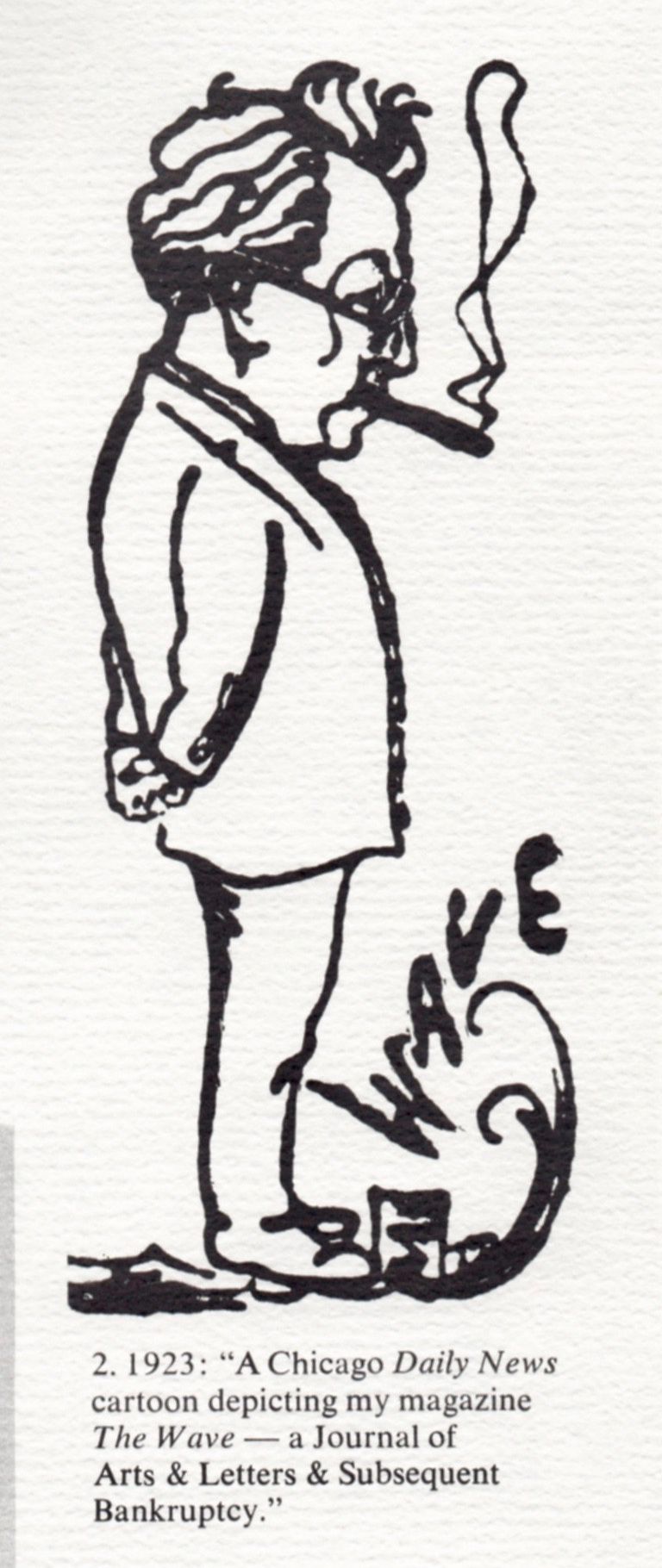Digging up a new/old Starrett illustration
Uncovering a Buried Caesar of our own
Editor’s Note: This started out as a Facebook post and kept growing until I knew it was now a blog post. And that is the kind of meticulous, well-planned effort we are known for here at Studies in Starrett World Headquarters.
An illustration from page 33 of The Last Bookman by Peter Ruber.
Regular readers of Studies in Starrett will know that I have a fascination with every Vincent Starrett image. I’ve tracked down photos and artwork of all types over the years.
There is one illustration in Peter Ruber's The Last Bookman that has frustrated me, because I've never been able to track down its original publication.
The illustration shows Starrett on the beach as a wave comes crashing in, literally spelled out as WAVE. The reference is to the little literary magazine Starrett briefly edited at the end of that overheated era known as the Chicago Renaissance. (You can learn more about The Wave here. )
Under the Ruber illustration is a note that says it’s from the 1923 Chicago Daily News. Starrett jokes about the magazine's title when he calls it "A Journal of Arts & Letters & Subsequent Bankruptcy."
The archives of the Daily News are not online, so I’ve been frustrated in my search for more information.
Then a few months ago I purchased a nicely inscribed copy of Starrett's book, Buried Caesars. The book is inscribed to “L. Andersen, with cordial regards,” which sounds like the kind of inscription he would write when he knew nothing about the book’s new owner.
I also know nothing about L. Andersen, but I am grateful to him/her, because a few pages into the book were tucked two book reviews clipped from newspapers of the era.
(BTW, the clippings must have been untouched for decades, because they’ve made “shadow” impressions on the pages were they lived for the last 9 decades plus.)
The most exciting clipping came from a column by Harry Hansen, a well-known Chicago writer who was Literary Editor of the Daily News in the early 1920s. Hansen and Starrett were old friends and had worked together for years on the Daily News. In his review, Hansen warmly recommended Starrett’s book.
A side note: For those who are unfamiliar with Buried Caesars, it’s an anthology of essays of literary appreciation, published in 1923 by the Covici-MacGee Co. of Chicago. The essays were originally written by Starrett for Reedy’s Mirror and other now-obscure publications.
In those years of the early 1920s, Starrett felt it was his role to bring attention to up-and-coming authors or to senior practitioners whose work had been ignored by the reading public. As Starrett described fulsomely in his introduction (take a deep breath now):
“I belong to the ‘Reedy School of criticism,’ which, if often it stresses the perpendicular pronoun, or seems oracular, does so in all sincerity, with considerable gusto, and for the benefit not so much of established reputations as for reputations either yet to be made or that have suffered from neglect. I have only small respect for criticism as it is generally practiced, and make no pretence of being a critic in any official sense. It is to be noted that the essays which follow are essays in literary appreciation."
Depending on your reading pleasure, you might or might not recognize the subjects of his essays: Arthur Machen, Ambrose Bierce, Stephen Crane, James Branch Cabell, W.C. Morrow, Arthur Cosslett Smith, Hubert Crackanthorpe, Richard Middleton, Opie Read, Walter Blackburn Harte, Haldan MacFall, Robert Nelson Stephens, David Ker, and William Marion Reedy, who founded Reedy’s Mirror, and was Starrett’s first advocate and editor.
Back to Hansen’s review. He recounts sitting around the Daily News newsroom when both he and Starrett were younger men and the news business was slow.
We can recall sitting around with him during the late watch on this newspaper ages ago and hearing him discourse on “The Hill of Dreams,” “The Open Boat,” and “In the Midst of Life” — days when he pronounced Machen as if it rhymed with Gretchen and when a stock of old book catalogues were as the wine of life to him.”
That sounds about right.
Hansen sums up his review by saying,
Buried Caesars, then, becomes the sort of book that leads one to other books and outlines in advance what sort of fare one will find there. In that capacity it will prove invaluable to the seeker after riches in the byways of literature. But for those already initiated into the charmed circle, the book will be like a renewal of friendships, rare and epic as friendship itself.
Accompanying the review, to my delight, is a clear relative of the illustration in Ruber’s book. I’ve posted a much larger version of that illustration here. A few observations:
The illustration shows a Starrett who would have been very familiar with those who knew him. The shock of wavy hair, the ever-present cigar, the studious pose and the glasses are all in their familiar place, as is his rather prominent nose.
At his feet is the crashing wave of water, with WAVE spelled out and etched in soft lettering.
There is a little square box at Starrett’s left foot which reads, “Hec Mann—1922.”
The attribution to the artist is confirmed by the credit line that comes after Starrett’s name at the bottom of the illustration.
Now, let’s compare the two illustrations.
The Daily News version contains fine lines that accentuate the figure and humor in the caricature.
The Ruber version has thick, black lines that obscure certain features of Starrett’s face.
The two men are looking in opposite directions.
Check out the way the word WAVE is spelled out. The Daily News version starts at the curl of the wave and reads down to the right to Starrett’s shoe. The Ruber version starts at the knee and works it way up and over the curl.
Interestingly, the box with Mann’s name in it has a thick black scrawl going through it in Ruber’s reproduction. If Mann’s name was in that box, it is now unreadable.
I’m guessing—and it’s only a guess—that the Last Bookman illustration may have been an early design by Mann, acquired by Starrett and stashed in a drawer until Ruber came along.
That seems a reasonable supposition. and will have to do until more information comes along.
A portion of the back of Hansen’s review, with a date of Wednesday, Oct. 21, 1923.
But we can surely learn more, don’t you think?
Let’s try for a date of Hansen’s review. As I said earlier, the files of the Chicago Daily News are not online. So we need to work other sources.
And here we are in luck, because the back of clipping has a date of Wednesday, October 21, 1923. Until we get confirming evidence, that’s where the date will have to stay, I think.
Speaking of dates, why did Mann say this was done in 1922, when in fact it was published in 1923? It’s possible that the illustration was originally done to promote Starrett’s little magazine The Wave, which published most of its issues in 1922.
Having drawn the man once, it makes sense the Daily News would pull out the old illustration and use it to go along with Hansen’s review. After all, Starrett had not changed that much in a year, except to become poorer for the bad fortunes of The Wave.
The dust jacket to Buried Caesars.
And now for a word about the artist: Hec (short for Heathcote—well wouldn’t you?) Mann is not easy to trace. Noodling around in various sources, I think I’ve got a basic picture.
Mann was born in New Zealond where he had been a cartoonist. He did manual labor to get himself to the United States and to Illinois.
He worked as an engraver, illustrator and cartoonist for various publications in Mt. Morris, in the Northern Illinois area, just a few hour’s drive west of Chicago.
We’ll leave the last word to Starrett, not on the illustration, but on the book itself. In his bibliography of Starrett’s early work, Charles Honce has one note from the author as he looked back on his work of more than 20 years before:
“(These are) My adolescent enthusiasms; I now prefer Sherlock Holmes.”
We could not agree more.


